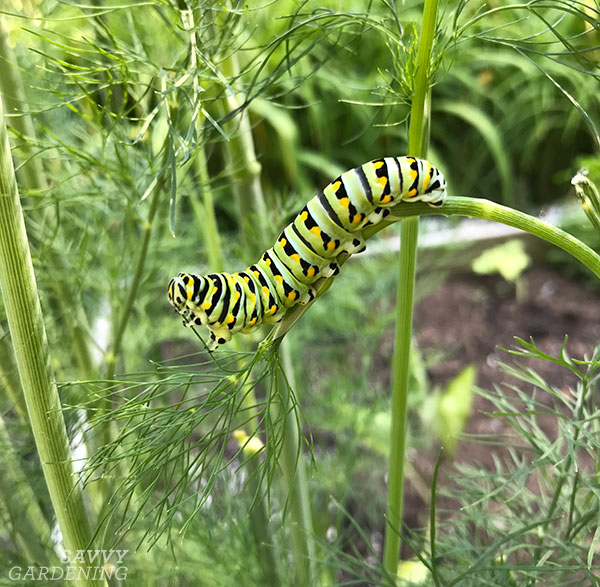How To Raise A Eastern Black Swallowtail Caterpillars From Your Garden
When you see a caterpillar on dill in your garden—or other plants—you may be startled, grossed out, or annoyed that your plant is being systematically decimated. I get excited. Because I know it's a black swallowtail (Papilio polyxenes) caterpillar that's going to turn into a beautiful butterfly. And that butterfly is going to become one of many valuable pollinators in my garden.
I see numerous types of swallowtail butterflies fluttering about my property, landing on various annuals and perennials. They are among the largest and most common butterflies we see in our gardens—there are about 550 swallowtail species in the world! The black swallowtail (often referred to as the Eastern black swallowtail) can be found throughout much of North America.
The tails on the hind wings of a swallowtail butterfly look like that of a barn swallow, which is how they got their common name.

A lot of articles focus on plants that attract bees, butterflies, and hummingbirds. But it's also very important to provide plants and trees for the larval caterpillar stages. These are called host plants. Jessica wrote a great article listing plants that are larval food sources for some of North America's butterflies. Today I'm going to focus on identifying and feeding black swallowtail caterpillars.
Finding and identifying a caterpillar on dill or other black swallowtail host plants
Where I live in Southern Ontario, I have found caterpillars on my dill plants anywhere from early June to the end of August. There are two generations or broods of swallowtail butterflies over the growing season.

Finding the eggs is tricky—I usually end up just finding the caterpillars. But if you're looking, the eggs look a bit like tiny yellow fish roe. Caterpillars go through five "instars" or stages of development. And they can look very different in their younger stages than when they're plump and ready to form a chrysalis.
Through each instar stage, the caterpillar molts its skin. In the early instar stage, caterpillars look a bit like bird droppings, probably to deter predators. They're black in color with orange dots and a white center, and it looks like they have little spines on their back. As they grow, the middle instar swallowtail caterpillar stage still includes spines, but the caterpillar is more black and white striped with yellow spots. During later instar stages, the swallowtail caterpillar becomes a lime green color with black and yellow stripes. That spiny back disappears. And they are closer to forming a chrysalis. My hope is always that they pupate before the birds find them!

What to grow to feed black swallowtail caterpillars
One type of plant does not feed all butterfly caterpillars. They all rely on different plant species, known as host plants. For example, milkweed is the only larval host plant of the monarch butterfly caterpillar. Black swallowtail caterpillars rely on members of the Apiaceae or Umbelliferae family, which include dill, carrot tops, parsley, fennel, rue, and Queen Anne's lace.

There are also some native plant species that are host plants to black swallowtail caterpillars, including golden Alexander (Zizia aurea) and yellow pimpernel (Taenidia integerrima). The blooms of both resemble dill flowers.

My recommendation if you're growing herb plants, like parsley and dill, is to plant a few in different places in the garden. That way you'll have lots to enjoy on your plate and the swallowtail caterpillars will have lots to enjoy as they move through their instar stages.
What to do if you see a caterpillar on dill and other host plants
The short answer is to let them eat! The other answer is grow more of what they like to eat if their appetite is interfering with your crops. I let my dill go to seed in my garden, so I have a LOT of dill plants from spring through fall. I simply pull the ones that get in the way of planting other veggies and herbs, but there is plenty left over for the caterpillars—and my meals.

You can also (gently) move a swallowtail caterpillar on dill to another host plant, though they don't like to be moved when they're ready to molt. When alarmed, what look like little orange antennae come out. And they emit an odor. Those "antennae" are actually an organ called an osmetierium, which is used to warn predators.

More pollinator-friendly advice, identification, and growing tips
The book Gardening For Butterflies by the Xerces Society is helpful when it comes to identifying the types of butterflies you may find in your garden, as well as what to plant to support both the caterpillar and butterfly stages of life.
- The monarch butterfly host plant: Milkweeds and how to grow them from seed
- Foraging habitat for pollinators: What to plant in sun and shade
- Pollinator garden design: How to get started attracting bees, butterflies, and birds
- Attracting more bees and pollinators: 6 ways to help our native insects
- Types of bees commonly found in yards and gardens
- Hummingbird flowers to add to your garden

How To Raise A Eastern Black Swallowtail Caterpillars From Your Garden
Source: https://savvygardening.com/caterpillar-on-dill/
Posted by: petersonagaisaink1965.blogspot.com

0 Response to "How To Raise A Eastern Black Swallowtail Caterpillars From Your Garden"
Post a Comment